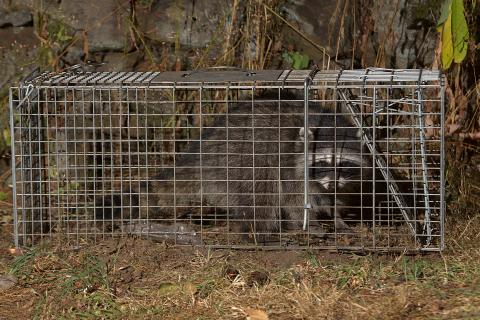Find help...
How to trap and remove a raccoon in Massachusetts | Raccoon
Massachusetts > Animal is eating my garden plants and vegetables > Raccoon
How to trap and remove a raccoon
Raccoons are relatively easy to catch in traps. A cage or box trap should be used in populated areas or if you have free-ranging pets in your neighborhood. Use a well-built trap that is at least 10-inches by 12-inches by 32-inches. Place the trap on a level area and make certain the area around it is free of items that a raccoon might grasp and pull to the trap. When placing cage traps on roof tops, a protective piece of plywood or similar barrier that extends approximately one-foot out on all sides is necessary to protect shingles from being torn. Prevent baited cage traps from being rolled over by anchoring them with stakes. Secure traps set in other locations with strapping metal or other anchors to prevent sliding off roofs, etc. Bait the traps with sweet fruit (e.g., cherries or grapes), marshmallows or jelly to reduce the chance of catching non-target animals. Place a pile of bait behind the trigger and scatter a little bait outside the opening of the trap and just inside the trap entrance. Make sure the back of the trap is screened with ½-inch mesh or smaller to prevent raccoons from reaching the bait without entering the trap.
Because raccoons often carry rabies, they should not be relocated when live-trapped. Some states do not allow relocation. Raccoons should be released on your property following repair of openings, but the potential for recurring damage and for conflicts with other landowners should also be considered when making this decision. If releasing the raccoon nearby is not an option, humanely euthanize it with .22-caliber rifle or pistol, or by placing it in a carbon dioxide chamber. If the raccoon is going to be tested for rabies, then do not shoot it in the head.
Note: Discharging firearms in developed areas is often prohibited by local safety ordinances and state hunting laws.
For assistance in the control of problem raccoons, contact a licensed wildlife control operator in your area.
Hunting and trapping during established, regulated seasons can be effective in removing nuisance individuals and lowering the local population.
Legal, Regulated Trapping in Massachusetts
Legal, Regulated Trapping in Massachusetts
The use of legal, regulated, trapping by licensed trappers can be useful for reducing local wildlife populations and can help reduce nuisance problems in Massachusetts.
Laws and regulations to be aware of
Regulations for Massachusetts
|
||||
While we attempt to provide guidance about state and federal regulations pertaining to specific species and control techniques, we do not provide information about local jurisdictions (city, town, county, etc.) where regulations may be more restrictive, especially as it applies to discharge of firearms, transport of animals or use of trapping equipment. Contact your local city or county government to inquire further. No guarantee is made that information (or lack of information) associated with a species or control technique is completely accurate or current. You should become familiar with federal, state and local laws before beginning any wildlife control activities. |
More solutions for raccoon problems




